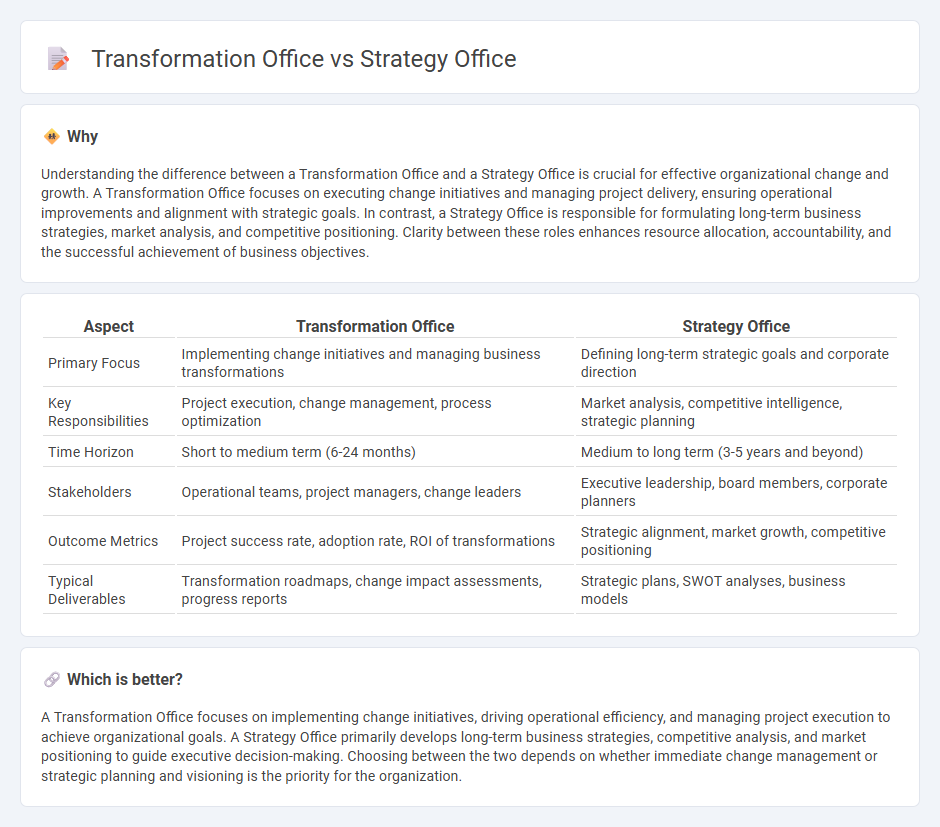
Transformation offices focus on driving organizational change through project management, process optimization, and technology adoption, ensuring alignment with business goals. Strategy offices concentrate on long-term planning, competitive analysis, and resource allocation to position the company for sustainable growth. Discover how choosing the right office can accelerate your company's success.
Why it is important
Understanding the difference between a Transformation Office and a Strategy Office is crucial for effective organizational change and growth. A Transformation Office focuses on executing change initiatives and managing project delivery, ensuring operational improvements and alignment with strategic goals. In contrast, a Strategy Office is responsible for formulating long-term business strategies, market analysis, and competitive positioning. Clarity between these roles enhances resource allocation, accountability, and the successful achievement of business objectives.
Comparison Table
| Aspect | Transformation Office | Strategy Office |
|---|---|---|
| Primary Focus | Implementing change initiatives and managing business transformations | Defining long-term strategic goals and corporate direction |
| Key Responsibilities | Project execution, change management, process optimization | Market analysis, competitive intelligence, strategic planning |
| Time Horizon | Short to medium term (6-24 months) | Medium to long term (3-5 years and beyond) |
| Stakeholders | Operational teams, project managers, change leaders | Executive leadership, board members, corporate planners |
| Outcome Metrics | Project success rate, adoption rate, ROI of transformations | Strategic alignment, market growth, competitive positioning |
| Typical Deliverables | Transformation roadmaps, change impact assessments, progress reports | Strategic plans, SWOT analyses, business models |
Which is better?
A Transformation Office focuses on implementing change initiatives, driving operational efficiency, and managing project execution to achieve organizational goals. A Strategy Office primarily develops long-term business strategies, competitive analysis, and market positioning to guide executive decision-making. Choosing between the two depends on whether immediate change management or strategic planning and visioning is the priority for the organization.
Connection
Transformation Office drives organizational change by implementing strategic initiatives aligned with the company's long-term goals, while the Strategy Office formulates these overarching plans based on market analysis and competitive positioning. Both offices collaborate closely to ensure that strategic objectives are translated into actionable projects, enabling seamless execution and measurable business impact. This synergy optimizes resource allocation, enhances stakeholder engagement, and accelerates corporate growth through focused transformation efforts.
Key Terms
Vision Alignment
The Strategy Office primarily concentrates on long-term vision alignment and setting organizational goals to ensure all departments work cohesively toward a shared future. The Transformation Office focuses on executing change initiatives and managing projects that bring the strategic vision into operational reality. Discover how integrating both offices can drive sustained business success and seamless vision execution.
Change Management
The Strategy Office drives long-term organizational goals, aligning initiatives with corporate vision, while the Transformation Office specializes in implementing change management to ensure seamless execution of strategic shifts. Change management within the Transformation Office emphasizes stakeholder engagement, communication plans, and resistance mitigation to foster adoption and sustainable transformation. Explore detailed frameworks and best practices to enhance change management effectiveness in both offices.
Performance Metrics
The Strategy Office focuses on setting long-term organizational goals and aligning performance metrics with overall business objectives, emphasizing strategic KPIs such as market share growth and revenue targets. In contrast, the Transformation Office drives change initiatives by monitoring operational performance metrics, including process efficiency, adoption rates, and project milestones to ensure successful implementation. Explore how integrating both offices can enhance your company's performance measurement framework.
Source and External Links
Defining The Office of Strategy Management - The Office of Strategy Management (OSM) is a corporate-level function responsible for overseeing all strategy-related activities from formulation to execution, helping organizations close the gap between strategic planning and implementation by integrating governance with business operations in a culture of accountability.
The Power of an Effective Office of Strategy Management - An OSM bridges strategy and implementation by creating and managing the strategy management system, aligning corporate strategy across the organization, communicating strategy workforce-wide, and driving performance through strategic reporting and tracking tools.
Creating the Office of Strategy Management - The OSM helps achieve organizational alignment by linking corporate, business unit, and support strategies through tools like the Balanced Scorecard, ensuring integrated planning, budgeting, and workforce alignment to deliver on strategic objectives.
 dowidth.com
dowidth.com